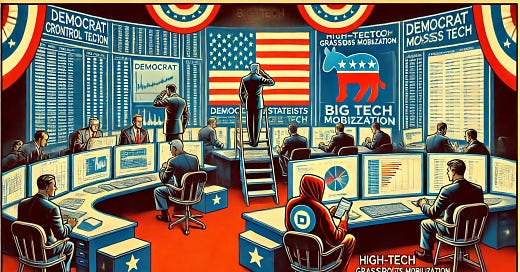Welcome to the 16th installment of the VICI Report, a comprehensive multi-part series exploring the sophisticated use of technology in political operations. This series aims to uncover the processes, mechanisms, tools, and technologies used by Democrats to master our political processes and to develop strategies which answer and ultimately defeat their manipulations in 2024 and beyond.
Your support is critical to the success of this mission. Please help by sharing or consider becoming a free or paid subscriber.
Introduction
The Democrat tech ecosystem is a meticulously crafted network, integrating advanced technology, big data, and grassroots activism to create a formidable political machine. Over the past few decades, left-wing ideologies have permeated venture capital and corporate finance, embedding Critical Theory, ESG, and DEI into the core of business operations. This ideological infiltration has transformed traditional profit-driven motives into vehicles for social engineering, compelling companies to adopt leftist agendas to secure essential investments.
As the tech industry became a battleground for ideological control, early principles like Google's "Don't be evil" have morphed into frameworks like Effective Altruism, justifying extreme measures under the guise of social good. Simultaneously, the influx of cheap money and global investment strategies have detached valuations from reality, creating inefficiencies and fostering internal social agitation within companies.
Understanding the intricate collaboration within this ecosystem is crucial for comprehending its political prowess. From big data analytics to digital grassroots mobilization, the Democrat tech ecosystem exemplifies a sophisticated approach to influencing voter behavior and election outcomes, revealing both its strategic brilliance and its potential pitfalls.
Read the previous installment:
or read from the beginning:
Synergy of Interests and Roles
The Democrat tech ecosystem is a highly interconnected network where numerous companies and projects collaborate seamlessly. This integration allows for efficient data sharing, strategic planning, and execution of political campaigns. The collective effort of these entities creates a robust infrastructure that maximizes voter engagement and turnout, demonstrating the power of coordinated strategy and advanced technology.
A key aspect of this ecosystem is its integration with traditional non-profits through their data and technology vendors. Non-profits focused on social justice issues, for example, may use advanced data analytics tools to identify and engage potential supporters. The data from these non-profits, though not overtly political, can be used to enhance the efforts of ballot harvesting non-profits or Democrat campaigns due to shared, politically aligned vendors.
A person receptive to a local-centric environmental group is more likely to be receptive to Democrat politics, making this indirect collaboration a critical component. This alignment amplifies the ecosystem's impact by leveraging the shared technology and data of these vendors.
Big Tech corporations play a crucial role in this ecosystem in multiple ways. Companies like Google, Facebook, and Twitter provide platforms and tools that support Democrat political strategies. While these companies have "banned" political advertising and officially ceased providing political campaigns with the same quality data they previously offered, they now supply this data to Democrat-aligned non-profits for GOTV and other voter contact canvassing.
This approach was exemplified by Zuckerberg's $400 million contribution in 2020, which was largely used for these purposes. Additionally, Big Tech companies allow aligned developers to take leaves of absence to work on political tech projects, with stipends often funded by Impact Investment advisors like Arabella Partners. This process aligns with the ideological infiltration and takeover across all educated professions, further integrating Big Tech into the Democrat tech ecosystem.
The collaboration within this ecosystem extends beyond direct partnerships. The scope of the ecosystem involves data and activity from various vendors at different stages feeding into each other. This allows billions of dollars of investment capital and non-profit donation capital to play a role in the Democrat ballot harvesting machine without "hard" money being spent or otherwise trackable.
Media organizations shape public opinion, tech startups develop innovative tools for political engagement, and educational institutions cultivate the next generation of tech-savvy activists. The seamless integration of these roles and interests enhances the overall effectiveness of the Democrat tech ecosystem, making it a powerful force in shaping political outcomes.
Moreover, this type of collaboration raises significant legal and ethical concerns. The intertwining of non-profit and political campaign activities, facilitated by shared vendors and aligned interests, might be illegal and warrants thorough investigation by law enforcement. The potential misuse of non-profit status, the blending of tax-deductible donations with political operations, and the covert flow of data and resources across aligned entities demand rigorous scrutiny. Understanding the synergy within this ecosystem reveals the strategic sophistication behind Democrat political operations and underscores the urgent need for accountability and transparency in these practices.
Big Data and the Voter
The use of big data tools and technologies is central to Democrat political campaigns today. These tools enable detailed voter profiling, allowing campaigns to tailor their messages to specific demographics with pinpoint accuracy. Data collection methods include social media analytics, voter databases, and online behavior tracking, which together provide a comprehensive view of potential voters. By analyzing this data, campaigns can identify trends, preferences, and behaviors, creating highly targeted outreach strategies that significantly increase voter engagement and turnout.
One of the striking similarities between Democrat digital campaigning and modern business practice is the use of profile marketing and customer relationship management (CRM) techniques. In the business world, companies use data-driven strategies to manage customer interactions, segmenting and targeting customers based on detailed profiles and driving customers towards desired responses. Democrat campaigns have adopted these techniques to manage voter interactions in a similar manner. By applying data-driven approaches, these campaigns efficiently allocate resources, prioritize outreach efforts, and craft messages that resonate deeply with their targeted voter segments.
Sales management pipelines, a staple in business operations, have their counterparts in political campaigns. Voter data is segmented and targeted similarly to sales prospects, with campaigns using sophisticated data analytics to prioritize outreach efforts and maximize impact. This approach allows campaigns to focus on high-value targets, ensuring that their efforts are both efficient and effective. By mirroring sales management pipelines, Democrats streamline their operations and improve their overall efficiency.
The promise of personalized marketing, a key component of early internet ambitions, has been fully realized in the political realm through data-driven manipulation. Campaigns craft personalized propaganda based on detailed voter profiles derived from data available from social media titans, ensuring that their messages resonate with individual voters. This approach leverages big data insights to influence voter behavior on an individual level. Personalized propaganda is crafted to address the specific concerns and interests of individual voters, making campaign messages more persuasive and impactful.
Big data tools and technologies also play a crucial role in the broader Democrat tech ecosystem by enabling the integration and coordination of various campaign activities. The data collected from different sources is used to create a cohesive strategy that spans multiple platforms and outreach efforts. This integration allows campaigns to maintain a consistent message and approach across all channels, enhancing the overall effectiveness of their efforts.
This seamless integration of data-driven strategies with campaign activities extends to the grassroots level, where digital tools empower activists and volunteers. By understanding the role of big data in shaping voter interactions, we can better appreciate the strategic depth of the Democrat tech ecosystem and its ability to leverage advanced technologies to achieve its political objectives. Activists use these tools to drive digital grassroots efforts, creating a powerful feedback loop that further amplifies campaign effectiveness.
Activists, Tools, and the Digital Grassroots
Digital tools play a crucial role in grassroots activism, serving as both inputs and outputs within the broader data and voter management efforts of Democrat political campaigns. These tools collect valuable data from activist actions and feed it back into the system, refining and enhancing overall strategy. This feedback loop ensures that campaigns remain agile and responsive to changing dynamics, continuously optimizing their efforts.
The Democrats have mastered the use of these digital tools to create a CRM-style pipeline that attracts and manages like-minded, activist-minded individuals. By organizing activities ranging from event promotion to complex street canvassing, these tools ensure coordination and impact. Activists receive real-time updates and instructions, allowing campaigns to mobilize quickly and efficiently. Leveraging these digital platforms, Democrat campaigns can strategically direct efforts, maximizing the effectiveness of grassroots initiatives.
Campaigns use these digital tools to direct and reap benefits from activist actions, whether it involves simple tasks like event promotion and fundraising or more complex efforts like personalized local street canvassing. Personalized engagement plans and targeted interaction scripts are crucial in this process. Activists are provided with detailed voter profiles and contact histories, enabling them to engage voters in informed and persuasive conversations. This approach enhances the effectiveness of both traditional door-to-door canvassing and digital outreach, ensuring every interaction is meaningful and impactful.
The ability to individualize outreach and activism at scale using technology represents a significant advancement in political campaigning. Traditional canvassing methods are now complemented by digital techniques that allow for more efficient and personalized voter contact. Canvassers can access individual profiles and contact histories on their phones, integrate voter data into relational graphs for instant analysis, and optimize their routes to avoid wasting time on already convinced or impossible to convince voters. This integration of traditional and modern methods significantly enhances the reach and efficiency of campaign efforts.
The synergy between technology and grassroots activism within the Democrat tech ecosystem generates a powerful dynamic. Activist actions produce valuable data that continuously refines campaign strategies, ensuring every effort is optimized for maximum impact. This strategic sophistication enables the Democrat tech ecosystem to leverage grassroots activism effectively, achieving its political objectives through coordinated and data-driven efforts. By harnessing the power of digital tools, Democrats have created a formidable grassroots operation that not only mobilizes support efficiently but also adapts swiftly to changing political landscapes.
Collusion and the Harvest
The Democrat tech ecosystem extends its influence through a complex network of non-profit organizations and strategic alliances, effectively transferring the responsibility for voter turnout from traditional campaign operations to the non-profit ecosystem. This strategy allows campaigns to channel vast resources into voter mobilization efforts without breaching campaign finance laws. By leveraging the legal and financial structures of non-profits, Democrats have crafted a sophisticated approach to ensuring voter engagement and turnout.
Effective Altruism, which emphasizes quantifiable results, drives many of these non-profit based strategies. Organizations focused on voter turnout and engagement adopt this principle to ensure their efforts are both efficient and measurable. This data-driven approach allows them to demonstrate tangible outcomes, attracting more funding and support. The focus on quantifiable impact ensures that every dollar spent directly contributes to increasing voter participation.
The ballot harvesting process, a cornerstone of Democrat voter mobilization strategy, necessitates a holistic collusive effort. This involves integrating data management, activist mobilization, and strategic planning to ensure ballots are collected and submitted effectively. By aligning these efforts, Democrats can systematically harvest ballots, maximizing voter turnout in key areas. The coordination between various entities, from local activists to national non-profits, creates a seamless operation that ensures every possible vote is counted.
The success of Democrat strategies in ballot harvesting is evident in historical and contemporary election outcomes. Leveraging advanced technology and coordinated efforts, Democrats have refined their processes to dominate voter turnout. Strategic use of data, coupled with grassroots mobilization, has created a powerful system that enhances their electoral advantage.
However, this intricate web of collaboration and strategic alignment raises significant legal and ethical questions. The blending of non-profit activities with direct political campaigning, facilitated by shared data and resources, might skirt or even violate campaign finance laws. The covert flow of funds and data through aligned entities demands rigorous scrutiny to ensure transparency and accountability. Law enforcement must investigate these practices to uphold the integrity of the electoral process and ensure that campaign finance regulations are not being subverted.
Understanding the depth and complexity of the Democrat tech ecosystem's approach to voter turnout reveals the sophistication of their strategies. By integrating non-profit operations with political campaigns, Democrats have created a formidable machine for mobilizing voters. This strategic alignment, while effective, necessitates careful examination to ensure it operates within legal and ethical boundaries.
Democrat Technology Categories
The Democrat tech ecosystem is a multifaceted network, strategically designed to maximize political influence and voter engagement. To fully understand its complexity, it is essential to categorize its components. This categorization not only provides clarity but also sets the stage for detailed analyses of each category in subsequent articles. The Democrat tech ecosystem can be described in five broad categories: Data and Research, Voter Relationship Management, Activist Marshalling, Finance and Fundraising, and Ballot Harvesting. Each category plays a crucial role in the overall strategy, and understanding them is key to comprehending the ecosystem's full impact.
Data and Research
Data and research form the backbone of the Democrat tech ecosystem. This category encompasses the tools and methodologies used for gathering and analyzing voter data. Advanced data analytics, social media monitoring, and voter databases allow campaigns to gain deep insights into voter behavior, preferences, and trends. By understanding these patterns, campaigns can craft targeted messages and strategies that resonate with specific demographics. The ability to predict voter behavior and tailor outreach efforts accordingly is crucial for effective voter engagement and mobilization.
Voter Relationship Management
Voter Relationship Management (VRM) is akin to Customer Relationship Management (CRM) in the business world. This category involves managing interactions with voters, maintaining detailed profiles, and tracking engagement over time. VRM tools help campaigns stay connected with voters, ensuring continuous communication and relationship building. By leveraging these tools, campaigns can personalize their outreach, making voters feel valued and heard.
Activist Marshaling
Activist marshaling focuses on organizing and mobilizing grassroots supporters. Digital tools play a significant role in this category, creating a CRM-style pipeline to attract and manage activists. These tools help coordinate activities ranging from event promotion to street canvassing, ensuring that every effort is impactful. Personalized engagement plans and real-time updates enhance the efficiency of activist efforts, making grassroots campaigns more effective.
Finance and Fundraising
Securing financial resources is vital for any political campaign, and this category includes the tools and techniques used to raise funds and manage campaign finances. Democrat-aligned non-profits, PACs, and other fundraising entities work together to channel funds into campaign-related efforts. This category addresses the differing requirements for managing small donors and potential investor-grade donors, integrating these diverse streams into a cohesive strategy. Digital platforms facilitate online fundraising, social media campaigns, and donor management.
Ballot Harvesting
Ballot harvesting is the process of collecting and submitting absentee or mail-in ballots on behalf of voters. This category involves strategies and tools used to ensure high voter turnout. By coordinating data management, activist mobilization, and strategic planning, campaigns and aligned activists systematically collect ballots and ensure they are counted. As the culmination of the entire ecosystem's processes and mechanics, ballot harvesting exemplifies the holistic nature of Democrat strategies. The tools facilitating this culminative process include advanced data analytics, coordinated activist efforts, and robust logistical planning.
Conclusion
The Democrat tech ecosystem is a sophisticated, interconnected network designed to maximize political influence and voter engagement. By categorizing this ecosystem into these segments, we can better understand its complexity and effectiveness. Each category plays a crucial role in creating a seamless operation that leverages advanced technology and coordinated efforts to achieve strategic political objectives.
In subsequent articles, we will explore the tools, players, and processes that drive each segment of this ecosystem. These detailed analyses will reveal the intricate mechanisms that make the Democrat tech ecosystem a powerful force in modern politics. Understanding how these components work together is essential for grasping the full scope of their influence on voter behavior and election outcomes. Be sure to read the following articles to gain a comprehensive understanding of these critical elements.
Sinistra Delenda Est!
The VICI Report and Project VICI are projects of UpHold America, led by Paul Porter (X:@PaulPorterPVB) and Jason Belich (X:@BelichJason).
The VICI Report series is a culmination of many months of sleepless nights; the product of exhaustive research and analysis into the technologies used in politics by a Democrat adversary excessively skilled at manipulating political outcomes.
Your support is critical to the success of this mission. Please visit our website, support our GiveSendGo, help by sharing this post, or consider becoming a free or paid subscriber.






